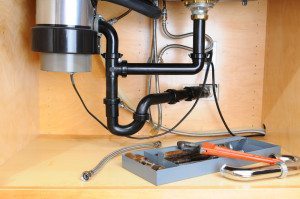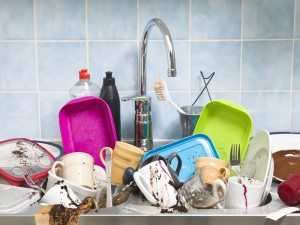You may be able to handle some garbage disposal repairs yourself, although serious issues are always best left to an expert. If your disposer isn’t working the way it should, try one of the  following fixes before calling in a repair person.
following fixes before calling in a repair person.
Check the Power
If you flip the disposer switch and nothing happens, you simply may not have power. Double-check to see if the disposal is plugged in — the power cord may have become dislodged from its socket below the sink.
If that isn’t the problem, take a look at your electrical service panel. A circuit breaker may have tripped or a fuse may have blown. If your disposal is on a dedicated circuit, you might not be aware of the problem until you try to use your appliance.
Try the Reset Button
If you’re certain that your appliance is getting power, you may simply need to reset the unit.
Disposals are equipped with an overload protection switch that turns the unit off automatically if it runs too long or becomes jammed. This overload protector is typically on the bottom of the disposal facing the floor. On most brands, it’s a small, red button.
If the button is popped out, try pressing it gently to reset the unit. You should hear a tiny click when it resets, similar to the sound the buttons on a GFI electrical outlet make. If the reset button keeps popping back out, unplug the disposer and wait about 10 minutes. Plug it back in and try the reset button again.
If this doesn’t work, or if the reset button continues to pop out, it’s time call an appliance repair technician.
Clearing a Jammed Disposal
Items can become stuck between the impeller blades and the drain hole in your garbage disposal.
You will definitely know if your disposal is jammed or clogged because the motor will hum but you won’t hear the blades turning or grinding. Or, it could begin running and then stop abruptly before you can turn it off. The jam may be caused by a bottle cap or a piece of food, such as a bone or fruit pit.
Begin by unplugging the power cord or turning off the breaker to the disposer. Next, use a flashlight and a pair of tongs — never your hands — to remove any materials stuck in the blades. If you are unable to remove the offending object, move on to the next step and go back for it later.
Look for a hex-shaped hole at the bottom of the unit. Insert a disposal wrench or an Allen wrench into the hole and turn it back and forth in both directions to free the impeller blades. Continue to work the wrench back and forth until you can turn the blades freely. Go back and try to remove the obstruction, if you weren’t previously able to retrieve it.
A Note of Caution
Back in the old days, people often tried to clear jams in their disposer by sticking a broomstick or heavy-duty screwdriver into the blades and compelling them to turn by brute force. Today, this is a very bad idea.
First, it’s dangerous to life and limb. Second, you can permanently damage the appliance and void your warranty. Third, it may be a useless waste of a perfectly good broom. If the wrench approach doesn’t work, you need professional help.
For all of your household appliance sales, installation and repair needs, trust Complete Appliance Repair, serving Woods Cross and the entire Salt Lake City area. Contact us today for all of your garbage disposal repair needs.


 convenient as it is, the disposal isn’t meant to handle every type of food. In fact, some items can
convenient as it is, the disposal isn’t meant to handle every type of food. In fact, some items can  maintenance at any sign of trouble may help prolong the life of your unit. But, as with any appliance, you may want to consider replacement at some point. Following are some signs that now may be the time to think about purchasing a new disposal.
maintenance at any sign of trouble may help prolong the life of your unit. But, as with any appliance, you may want to consider replacement at some point. Following are some signs that now may be the time to think about purchasing a new disposal.